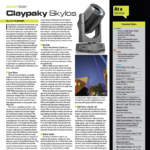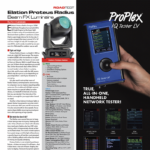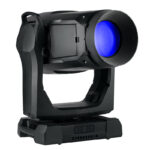Ayrton might be likened to the Apple of the LED lighting fixture world, creating fixtures we didn’t know that we wanted until we saw them. The utility of a moving-head strobe may not be immediately clear, and at first blush the idea of a pixel-mappable moving head strobe seems — perhaps — a little over the top. But play with the MagicBurst™ for an afternoon, or even a few minutes, and that opinion might change. While the concept is simple enough on the surface, there’s greater depth here than might be immediately apparent.
The earliest time I can personally remember hearing of the France-based company was in 2012, when I read a review of their WildSun 500C fixture, and it wasn’t until much later, with the success of the MagicPanel 602, that industry collectively perked up and paid attention. MagicBurst follows in the vein of its predecessors, a square-moving head panel of LEDs, but in no colors other than bright white, and as is so often the case, it is the skill and depth of the programming that can bring this fixture to its most vibrant potential.
The MagicBurst’s head is square, with no rounded edges on the perimeter, and the LED array is laid out in a grid of 64 pixels — eight pixels to a side — and 60 LED dies to a pixel. The pixels are not squares; instead, they look like what would be eight-by-eight grids with one emitter at each corner missing. These cutouts allow small areas for screws to hold the modules onto the head, giving the entire field of LEDs a grid-within-a-grid look. The modules are divided into four quadrants for the purposes of repairs; individual pixels are not user-replaceable. While visible, I do not believe these gaps would be distracting at expected viewing distances; the pixels look square from more than a few feet away. The remainder of the space behind the LED array is devoted to some large heatsinks, fans and LED electronics. The base follows the current Ayrton design scheme, with touch buttons and a color LCD screen for adjusting fixture modes and other settings.
Possible Uses
It is impossible to review a fixture like this without talking about the ways in which it might be programmed and used. This is a powerful fixture, but the visuals one can derive from it are only as good as the programming one puts in, and experience in programming pixel-mapped arrays will help users get the full experience this light is capable of providing. This MagicBurst defies categorization as either a straight strobe or a standard pixel-mapped moving head; it blends elements of both. In its Basic and Standard DMX modes, the user has access to the expected strobe attributes of rate and duration of the flashes, plus a wide variety of built-in effects macros, including static images like letters of the alphabet, numbers, faces and abstract shapes. There are also a variety of animated patterns, including lines, squares, clocks, checkerboards, dazzle patterns and other interesting visuals, and there are channels to adjust the “fade” between frames of animation and speed at which they play. The “standard” strobe functions such as ramps, random flashes, or spikes for either individual pixels or the head as a whole are lacking, though Ayrton advises they will add these features in the next software release.
In Extended mode, you have full pixel-mapping access to all 64 pixels on the head and control of their intensity, rate of strobe and duration, and the internal chases can be overlaid on top of pixel-mapped content to make some really interesting effects. This opens the door to a lot of possibilities, both in terms of control and visuals, and you’ll want to make sure to have enough rehearsal and programming time to wrap your head around all of the ways the control channels prioritize and interact with each other.
Control is via DMX, Art-Net, sACN, or a built-in LumenRadio wireless link using CRMX, and the fixture fully supports RDM. There is a built-in antenna for CRMX that pops out of the base, which is recessed into a small slot for protection, and which I found somewhat difficult to pull out. Ayrton provides several modes for controlling the unit, from a 12-channel Basic mode all the way up to 203 DMX channels in full pixel mapping mode. The software also includes an option to split control and pixel-mapping features across two universes, so you can patch a universe of head control (pan, tilt, and so forth) separately from universes of the pixels.
Output and Effects
Output from this unit is interesting. The light is rated to draw 1,400 watts at full tilt, and I measured an output of 2,540 lux at five meters. After running the fixture at full power for 20 minutes, this figure had dropped to 1,750 lux, which represents an output derating of 31.5 percent. Realistically, the brightness of flashes and bursts with this fixture are likely to be closer to this first figure, as the fixture’s cooling quickly allows the output to return to normal.
The color temperature is a pleasingly pure 5,600K white, and the LED dies have quite a wide angle of 120° — this is a fixture for hitting lots of eyeballs at once, not for making dramatic mid-air beams The dimming is not as smooth as we’ve seen from other Ayrton fixtures, with visible stepping happening below 15 percent or so and the LEDs popping on visibly at 1 percent. There is also a noticeable brightness dip as the fixtures hits around 95 percent on the dimmer, though this isn’t likely to be an issue in the context of a moving head fixture aimed primarily at producing strobe effects. The PWM frequency of the LEDs is 4,800Hz, which should be fast enough to avoid issues with cameras.
There’s another feature common to Ayrton fixtures to discuss here too, and that’s the infinite pan and tilt. This feature is separate from the standard pan and tilt channels, so you can treat this as a normal moving light for the majority of your programming. Using the standard positional channels gives you access to a pan and tilt range of 540º on both axes, (including tilt), and slow movements are quite smooth, without any noticeable jitter. (There is a menu option to limit tilt to a more familiar 270º.) Both axis take approximately 3.5 seconds to complete a 540º rotation.
Power input is via Neutrik PowerCON TRUE1 in and pass-through connectors, while DMX data is via standard 5-pin XLR connectors or through Ethernet via RJ-45, both with pass-through. The fixture weighs in at 18.9 kilograms (41.6 pounds) and has a 473 by 307mm base (18.6 by 12 inches) and stands 630mm (24.8 inches) tall. Rigging is via two industry-standard omega-style brackets. Power-up and home to final output is approximately 42 seconds.
Ayrton’s MagicBurst is a pleasant surprise. Large arrays of strobes are not new, but the brightness and wide beam angle of the elements give this fixture a unique look. The programming required to use it to its fullest potential is, like any pixel-mapped array, intense, and the success that users will have with this fixture is probably directly proportional to the amount of time dedicated to programming and content. This fixture fills a small market need, to be sure, but one I’m glad to see filled.
At a Glance:
Carving a Unique Niche
Necessity may be the mother of invention, but sometimes invention gives rise to need. Who would have thought, a decade ago, that a moving-head strobe would be a must-have, or, in the case of Ayrton’s MagicBurst, that need would extend to a moving-head strobe that is also pixel-mappable and capable of continuous rotation? While not for everyone, this fixture could be just the ticket for designers looking for truly unique lighting looks.
Ayrton MagicBurst
PROS: Lightweight; allows for some extremely sophisticated effects.
CONS: “Standard” strobe features not currently available. (Ayrton reports this will be added in the future).
FEATURES
- 3,840 mono-chip LED sources
- 240,000 lumen max output (5,600K)
- Rated for 50,000 hours of use
- Continuous pan and tilt rotation
- 5,600K white light strobe (1-25 fps)
- DMX-RDM compatible
STATS
- Size: 18.6” x 12” x 24.8” (WxDxH)
- Weight: 41.6 lbs.
- Wattage: 1400W
- MSRP: $10,360



